samsung SCD351-XAA, SCD351- XAO, SCD351- XAC, SCD351- XTC, SCD351- XAX Service Manual
...
DIGITAL VIDEO CAMCORDER
Chassis : Dragon (Delta III)
BASIC : SCD353
SCD353/XAA, XAO, XAC, XTC, XAX, RCL, XAP,
TWN, GEN, ZAM, SAM, AFS, XBG
SCD352/XAA, XAO, XAC, XTC, XAX, RCL, XAP,
TWN, GEN, ZAM, SAM, AFS, XBG
SCD351/XAA, XAO, XAC, XTC, XAX, RCL, XAP,
TWN, GEN, ZAM, SAM, AFS, XBG
SERVICE Manual 
DIGITAL VIDEO CAMCORDER |
|
Merit & Character regarding Product |
; Shooting Design DVC Leader
; Use Built-in Flash Memory
; Multi Memory Card Slot
; Direct Print System : PictBridge ™
; Power Nite Pix
; High quality MPEG4
; Still image Interpolation
; Real Wide mode (16:9)

1. Precautions
1.Be sure that all of the built-in protective devices are replaced. Restore any missing protective shields.
2.When reinstalling the chassis and its assemblies, be sure to restore all protective devices, including : control knobs and compartment covers.
3.Make sure that there are no cabinet openings through which people--particularly children --might insert fingers and contact dangerous voltages. Such openings include the spacing between the picture tube and the cabinet mask, excessively wide cabinet ventilation slots, and improperly fitted back covers.
If the measured resistance is less than 1.0 megohm or greater than 5.2 megohms, an abnormality exists that must be corrected before the unit is returned to the customer.
4.Leakage Current Hot Check (See Fig. 1-1) : Warning : Do not use an isolation transformer during this test. Use a leakage current tester or a metering system that complies with American National Standards Institute (ANSI C101.1, Leakage Current for Appliances), and Underwriters Laboratories (UL Publication UL1410, 59.7).
5.With the unit completely reassembled, plug the AC line cord directly the power outlet. With the unit’s AC switch first in the ON position and then OFF, measure the current between a known earth ground (metal water pipe, conduit, etc.) and all exposed metal parts, including : antennas, handle brackets, metal cabinets, screwheads and control shafts. The current measured should not exceed 0.5 milliamp. Reverse the power-plug prongs in the AC outlet and repeat the test.
6.X-ray Limits :
The picture tube is designed to prohibit X-ray emissions. To ensure continued X-ray protection, replace the picture tube only with one that is the same type as the original.
|
|
|
|
|
|
|
|
|
(READING SHOULD |
||
|
|
|
|
|
|
|
|
|
|
|
NOT BE ABOVE |
|
|
|
|
|
|
|
|
|
|
|
0.5mA) |
DEVICE |
LEAKAGE |
||||||||||
CURRENT |
|||||||||||
UNDER |
|
TESTER |
|||||||||
TEST |
|
|
|
|
|
|
|
|
|
|
|
|
TEST ALL |
|
|
|
|
|
|
|
|
||
|
|
|
|
|
|
|
|
|
|
||
|
|
|
|
|
|
|
|
|
|
||
|
EXPOSED METER |
|
|
|
|
|
|
|
|
||
|
|
SURFACES |
|
|
|
|
|
|
|
|
|
2-WIRE CORD |
|
|
|
|
|
|
|
|
|||
|
|
|
|
|
|
|
|
||||
ALSO TEST WITH |
|
|
|
|
|
|
|
EARTH |
|||
|
|
|
|
|
|
|
|||||
|
|
|
|
|
|
|
|||||
PLUG REVERSED |
|
|
|
|
|
|
|
||||
|
|
|
|
|
|
|
GROUND |
||||
|
|
|
|
|
|
|
|||||
(USING AC ADAPTER |
|
|
|
|
|
|
|
||||
|
|
|
|
|
|
|
|
||||
PLUG AS REQUIRED) |
|
|
|
|
|
|
|
|
|||
Fig. 1-1 AC Leakage Test
7. Antenna Cold Check :
With the unit’s AC plug disconnected from the AC source, connect an electrical jumper across the two AC prongs. Connect one lead of the ohmmeter to an AC prong.
Connect the other lead to the coaxial connector.
8.High Voltage Limit :
High voltage must be measured each time servicing is done on the B+, horizontal deflection or high voltage circuits.
Heed the high voltage limits. These include the X-ray protection Specifications Label, and the Product Safety and X-ray Warning Note on the service data schematic.
9.Some semiconductor (“solid state”) devices are easily damaged by static electricity.
Such components are called Electrostatically Sensitive Devices (ESDs); examples include integrated circuits and some field-effect transistors. The following techniques will reduce the occurrence of component damage caused by static electricity.
10.Immediately before handling any semiconductor components or assemblies, drain the electrostatic charge from your body by touching a known earth ground. Alternatively, wear a discharging Wrist-strap device. (Be sure to remove it prior to applying power--this is an electric shock precaution.)
Samsung Electronics |
1-1 |

Precautions
11.High voltage is maintained within specified limits by close-tolerance, safety-related components and adjustments. If the high voltage exceeds the specified limits, check each of the special components.
12.Design Alteration Warning :
Never alter or add to the mechanical or electrical design of this unit. Example : Do not add auxiliary audio or video connectors.
Such alterations might create a safety hazard. Also, any design changes or additions will void the manufacturer’s warranty.
13. Hot Chassis Warning :
Some TV receiver chassis are electrically connected directly to one conductor of the AC power cord. If an isolation transformer is not used, these units may be safely serviced only if the AC power plug is inserted so that the chassis is connected to the ground side of the AC source.
To confirm that the AC power plug is inserted correctly, do the following : Using an AC voltmeter, measure the voltage between the chassis and a known earth ground. If the reading is greater than 1.0V, remove the AC power plug, reverse its polarity and reinsert. Re-measure the voltage between the chassis and ground.
14.Some TV chassis are designed to operate with 85 volts AC between chassis and ground, regardless of the AC plug polarity. These units can be safely serviced only if an isolation transformer inserted between the receiver and the power source.
15.Never defeat any of the B+ voltage interlocks. Do not apply AC power to the unit (or any of its assemblies) unless all solid-state heat sinks are correctly installed.
16.Always connect a test instrument’s ground lead to the instrument chassis ground before connecting the positive lead; always remove the instrument’s ground lead last.
17.Observe the original lead dress, especially near the following areas : Antenna wiring, sharp edges, and especially the AC and high voltage power supplies. Always inspect for pinched, out- of-place, or frayed wiring. Do not change the spacing between components and the printed circuit board. Check the AC power cord for damage. Make sure that leads and components do not touch thermally hot parts.
18. Picture Tube Implosion Warning :
The picture tube in this receiver employs “integral implosion” protection. To ensure continued implosion protection, make sure that the replacement picture tube is the same as the original.
19.Do not remove, install or handle the picture tube without first putting on shatterproof goggles equipped with side shields. Never handle the picture tube by its neck. Some “in-line” picture tubes are equipped with a permanently attached deflection yoke; do not try to remove such “permanently attached” yokes from the picture tube.
20.Product Safety Notice :
Some electrical and mechanical parts have special safety-related characteristics which might not be obvious from visual inspection. These safety features and the protection they give might be lost if the replacement component differs from the original--even if the replacement is rated for higher voltage, wattage, etc.
Components that are critical for safety are indicated in the circuit diagram by shading, (  or
or  ).
).
Use replacement components that have the same ratings, especially for flame resistance and dielectric strength specifications. A replacement part that does not have the same safety characteristics as the original might create shock, fire or other hazards.
1-2 |
Samsung Electronics |

2. Product Specifications
2-1 Product Specification
|
Operation |
Description |
|
|
Video signal |
NTSC |
|
|
Video recording system |
2 rotary heads, Helical scanning system |
|
|
Audio recording system |
Rotary heads, PCM system |
|
|
Usable cassette |
Digital video tape (6.35mm width): Mini DV cassette |
|
System |
Tape speed |
SP: approx. 18.81mm/s LP: approx. 12.56mm/s |
|
Tape recording time |
SP: 60 minutes (when using DVM 60), LP: 90 minutes (when using DVM 60) |
||
|
|||
|
FF/REW time |
Approx. 150 sec. (using DVM60 tape) |
|
|
Image device |
CCD / 680K (Still Image : 48K) |
|
|
Lens |
F1.4 20x(Optical), 900x(Digital) Electronic zoom lens |
|
|
Filter diameter |
Ø30 |
|
|
|
|
|
|
Size/dot number |
2.5inchs 112k |
|
LCD monitor/Viewfinder |
LCD monitor Method |
TFT LCD |
|
|
Viewfinder |
B/W LCD |
|
|
|
|
|
|
Video output |
1Vp-p (751 terminated) |
|
|
S-video output |
Y: 1Vp-p, 751, C: 0. 286Vp-p, 751 |
|
Connectors |
Audio output |
-7.5dBs (6001 terminated) |
|
DV input/output |
4pin special in/out connector, |
||
|
|||
|
USB output |
Mini-B type connector |
|
|
External mic |
Ø3.5 stereo |
|
|
|
|
|
|
Power source |
DC 8.4V, Lithium Ion Battery Pack 7.4V |
|
|
Power source type |
Lithium Ion Battery Pack, Power supply (100V~240V) 50/60Hz |
|
|
Power consumption |
4.4W(LCD), 4.0W(Viewfinder) |
|
|
(Recording) |
|
|
General |
Operating temperature |
0˚~40˚C (32˚F~104˚F) |
|
Storage temperature |
-20˚C ~ 60˚C (-4˚F ~ 140˚F) |
||
|
|||
|
External dimension |
Length 90mm, Height 110mm, Width 60mm |
|
|
Weight |
400g (Except for Lithium Ion Battery Pack and tape) |
|
|
Built-in MIC |
Omni-directional stereo condenser microphone |
|
|
|
|
Samsung Electronics |
2-1 |
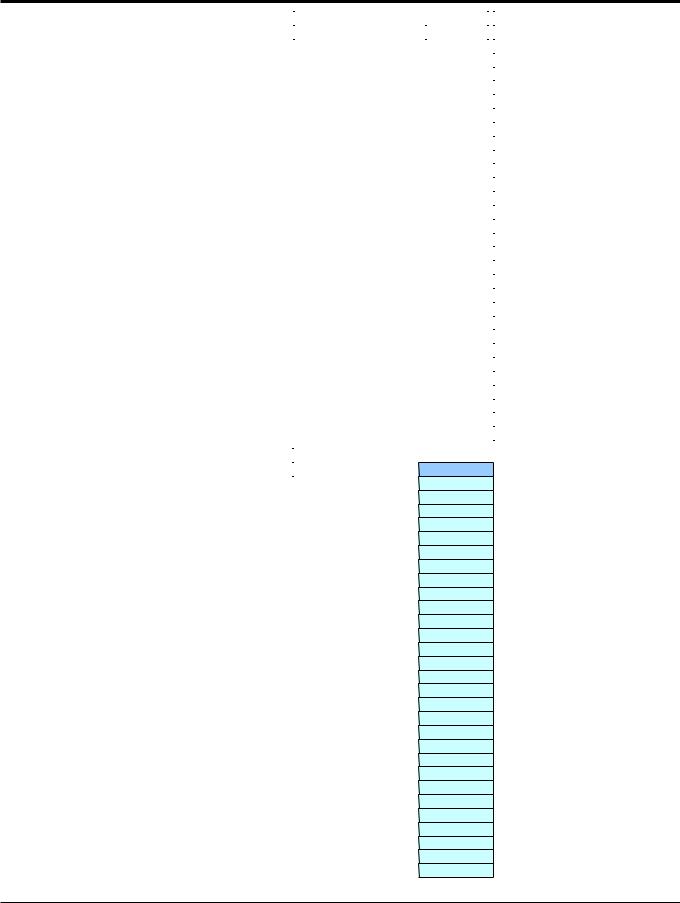
Product Specification
2-2 Chassis Product Specification
Region |
|
NTSC(America) |
|
NTSC (Rsx ) |
|||||
Model cod e |
D351 |
|
SC-D353 |
D355 |
|
VM-F730 |
|||
Form at |
O |
|
MiniDV |
O |
|
MiniDV |
|||
Resolution |
O |
|
520 line |
O |
|
520 line |
|||
Zoom/Digita l Zoom |
O |
|
20x / 900x |
O |
|
20x / 900x |
|||
CCD |
O |
|
680K |
O |
|
680K |
|||
LCD |
O |
|
2.5", 112K |
O |
|
2.5", 112K |
|||
Viewfinder |
O |
|
BW |
Color |
|
BW |
|||
Audio |
O |
|
12/16b PCM |
O |
|
12/16b PCM |
|||
Image Stabili zer |
O |
|
DIS |
O |
|
DIS |
|||
IEEE1394 |
O |
|
In/Out |
O |
|
In/Out |
|||
USB |
O |
|
USB2.0 |
O |
|
USB2.0 |
|||
USB Str eam. (For./size/F.Rate) |
O |
|
M4/VG/30f |
O |
|
M4/VG/30f |
|||
Web camera (For./size/F.rate) |
O |
|
MJ/QQ/15f |
O |
|
MJ/QQ/15f |
|||
Memory Card Slot |
- |
|
M.S. Slot |
Multi Card |
|
Multi Card |
|||
Builtin Memory |
- |
|
- |
|
32M |
|
16M |
||
Memory Card |
- |
|
- |
|
- |
|
- |
|
|
JPEG Recording Si ze to Memory |
O |
|
XGA |
O |
|
XGA |
|||
MPEG Clip Form at / size / F.Ratio |
O |
|
M4/VG/30f |
O |
|
M4/VG/30f |
|||
Continuous Shot / Im age Mix |
O |
|
T.B.D |
O |
|
T.B.D |
|||
JPEG Multi Displ ay |
O |
|
T.B.D |
O |
|
T.B.D |
|||
Light / Night Captur e / LSS |
O |
|
- / - / O |
O / O / O |
|
O/O/O |
|||
AV / S.Jack / Ext.Mic / H.phone |
|
|
O/O/O/- |
O |
|
O/O/O/- |
|||
Beep Sound / Displ ay / PB Zoom |
O/OSD/O |
|
O/GUI/O |
O |
|
O/GUI/O |
|||
Multi Lang./ Batt. Ch eck/Instant On |
O |
|
O/O/O |
O |
|
O/O/O |
|||
Analog In |
O |
|
- |
|
O |
|
O |
||
Remoc on / Acces sory Shoe |
O |
|
- / - |
|
O / - |
|
O/X |
||
Battery Pack |
O |
|
T.B.D |
O |
|
T.B.D |
|||
Carrying Case / Tape |
O |
|
Opt./Opt. |
O |
|
Opt./Opt. |
|||
S-Cable / Scart Jack |
O |
|
- / - |
|
O |
|
-/- |
|
|
Acces sory Comment |
O |
|
- |
|
O |
|
- |
|
|
|
|
|
|
|
|
|
|
||
Region |
|
|
PAL (Europ e) |
|
|
|
|||
Model cod e |
D351 |
|
D352 |
|
VP-D353 |
D355 |
|
|
|
Form at |
O |
|
O |
|
MiniDV |
O |
|
|
|
Resolution |
O |
|
O |
|
520 line |
O |
|
|
|
Zoom/Digita l Zoom |
O |
|
O |
|
20x / 900x |
O |
|
||
CCD |
O |
|
O |
|
800K |
O |
|
|
|
LCD |
O |
|
O |
|
2.5", 112K |
O |
|
|
|
Viewfinder |
O |
|
O |
|
BW |
Color |
|
||
Audio |
O |
|
O |
|
12/16b PCM |
O |
|
|
|
Image Stabili zer |
O |
|
O |
|
DIS |
O |
|
||
IEEE1394 |
O |
|
O |
|
Out |
O |
|
|
|
USB |
No |
|
O |
|
USB2.0 |
O |
|
|
|
USB Str eam. (For./size/F.Rate) |
No |
|
O |
|
M4/VG/25f |
O |
|
||
Web camera (For./size/F.rate) |
No |
|
O |
|
MJ/QQ/12.5f |
O |
|
|
|
Memory Card Slot |
No |
|
No |
|
M.S. |
Multi Card |
|
|
|
Builtin Memory |
- |
|
- |
|
- |
|
64M |
|
|
Memory Card |
- |
|
- |
|
- |
|
- |
|
|
JPEG Recording Si ze to Memory |
No |
|
No |
|
XGA |
O |
|
|
|
MPEG Clip Form at / size / F.Ratio |
No |
|
No |
|
M4/VG/25f |
O |
|
|
|
Continuous Shot / Im age Mix |
No |
|
No |
|
T.B.D |
O |
|
||
JPEG Multi Displ ay |
No |
|
No |
|
T.B.D |
O |
|
|
|
Light / Night Captur e / LSS |
-/-/O |
|
-/-/O |
|
O/O/O |
O |
|
|
|
AV / S.Jack / Ext.Mic / H.phone |
O |
|
O |
|
O/O/O/- |
O |
|
|
|
Beep Sound / Displ ay / PB Zoom |
O/OSD/O |
|
O/OSD/O |
|
O/GUI/O |
O |
|
|
|
Multi Lang./ Batt. Ch eck/Instant On |
O |
|
O |
|
O/O/O |
O |
|
||
Analog In |
O |
|
O |
|
- |
|
O |
|
|
Remoc on / Acces sory Shoe |
X/X |
|
X/X |
|
O/X |
O |
|
|
|
Battery Pack |
O |
|
O |
|
T.B.D |
O |
|
||
Carrying Case / Tape |
O |
|
O |
|
Opt./Opt. |
O |
|
|
|
S-Cable / Scart Jack |
O |
|
O |
|
Opt./Opt. |
O |
|
|
|
Acces sory Comment |
O |
|
O |
|
- |
|
O |
|
|
2-2 |
Samsung Electronics |
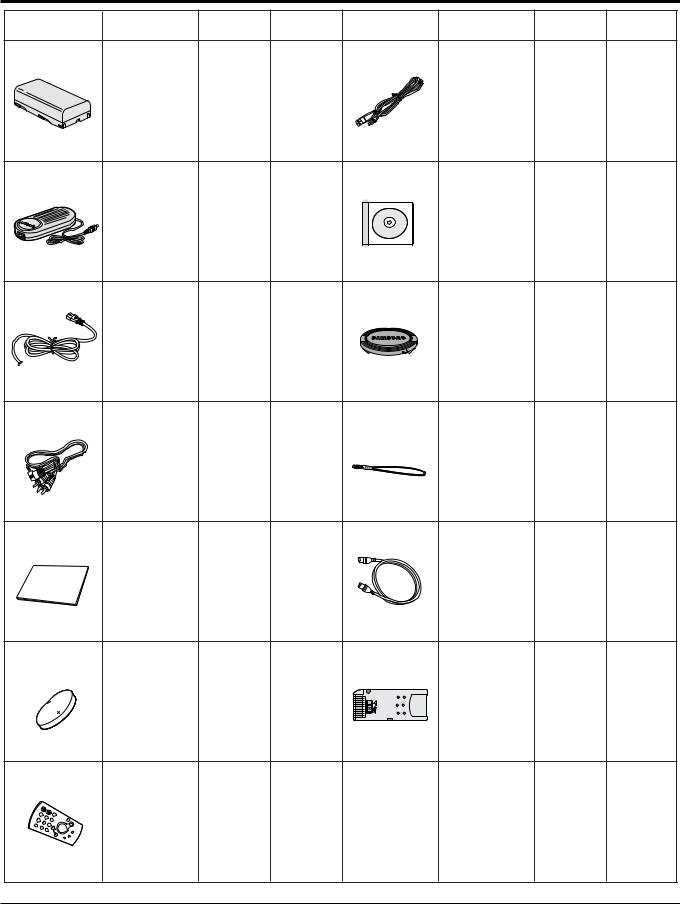
Product Specification
2-3 Accessories Supplied with Camcorder
Accessories |
Description |
Part No |
Remark |
Accessories |
Description |
Part No |
Remark |
|
|
|
Basic |
|
|
|
Basic |
|
|
|
Accessories |
|
|
|
Accessories |
|
|
AD43-00136A |
|
|
|
|
|
|
1. Lithium Ion |
|
|
|
8. USB Cable |
AD39-00073A |
(SCD352/ |
|
Battery Pack |
|
|
|
|
|
D353/D354/ |
|
|
AD43-00146A |
|
|
|
|
|
|
|
|
|
|
|
D355 only) |
|
|
|
|
|
|
|
|
|
|
|
|
Basic |
|
|
|
Basic |
|
|
|
Accessories |
|
|
|
Accessories |
|
2. AC Power Adapter |
AD44-00090A |
|
|
9.Software CD |
AD43-00128A |
(SCD352/ |
|
(AA-E8 TYPE) |
|
|
||||
|
|
|
|
|
|
|
D353/D354/ |
|
|
|
|
|
|
|
D355 only) |
|
|
|
Basic |
|
|
|
Basic |
|
|
|
Accessories |
|
|
|
Accessories |
|
3. AC Cord |
AD39-00076A |
|
|
10. Lens Cover |
AD97-07354B |
|
|
Basic |
|
Basic |
|
Accessories |
|
Accessories |
4. Audio/Video Cable |
AD39-00001A |
11. Lens Cover strap |
AD72-00049A |
|
Basic |
|
Optional |
|
Accessories |
|
Accessories |
5. Instruction Book |
AD68-00839B |
12. S-Video Cable |
AC39-42001Z |
|
Basic |
|
Optional |
|
Accessories |
|
Accessories |
6. Lithium Battery |
AD43-10130H |
13. Memory Stick |
1109-001221 |
(CR2025) |
|
|
|
Basic
Accessories
7. Remote Control |
AD59-00085A |
(SCD354/ |
D355 only)
Samsung Electronics |
2-3 |
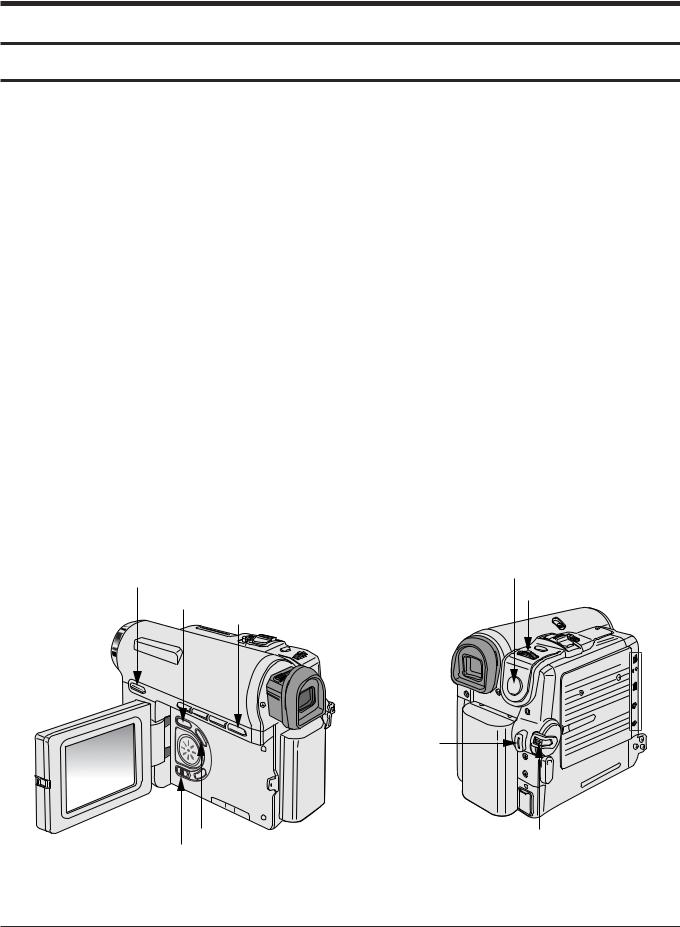
3. Alignment and Adjustment
3-1 VCR Adjustment
3-1-1 Adjustment Preparation
1)Before you start
ΠUse the buttons on the CAMCORDER when adjusting VCR.
´When changing the adjustment item, please press the “EASY-Q” and “DISPLAY” buttons on the CAMCORDER.
ˇ The adjustment value can be changed by moving the “MENU Selector” Left or Right. ¨ Press the “MENU Selector” to store each adjustment into EEPROM.
ˆ The OSD shows “OK” after finishing each adjustment step.
Ø In order to exit the adjustment mode, disconnect the power source.
2)Function of each buttons on the Set Key
|
<Table 3-1> |
|
|
|
|
Buttons |
Description |
|
MENU Selector push (Confirm) |
Stores changed value in the adjustment and auto adjustment mode. |
|
|
|
|
MENU Selector Right (Data Down) |
Changes data in the adjustment state. |
|
|
||
MENU Selector Left (Data Up) |
||
|
||
|
|
|
EASY-Q (Mode Up) |
Changes mode. |
|
DISPLAY (Mode Down) |
||
|
||
3) How to get into the VCR adjust mode |
|
|
[STEP 1] |
|
|
ΠConnect the Power source. |
|
´ Set the Power Switch to “PLAYER” position and Mode Switch to “TAPE” position.
MENU Button
EASY Q Button
MENU Selector
DISPLAY Button
STOP Button
DV
USB
AV
MIC
Start/Stop Button
PB ZOOM |
Power switch |
Mode switch |
|
|
Fig. 3-1 |
Samsung Electronics |
3-1 |
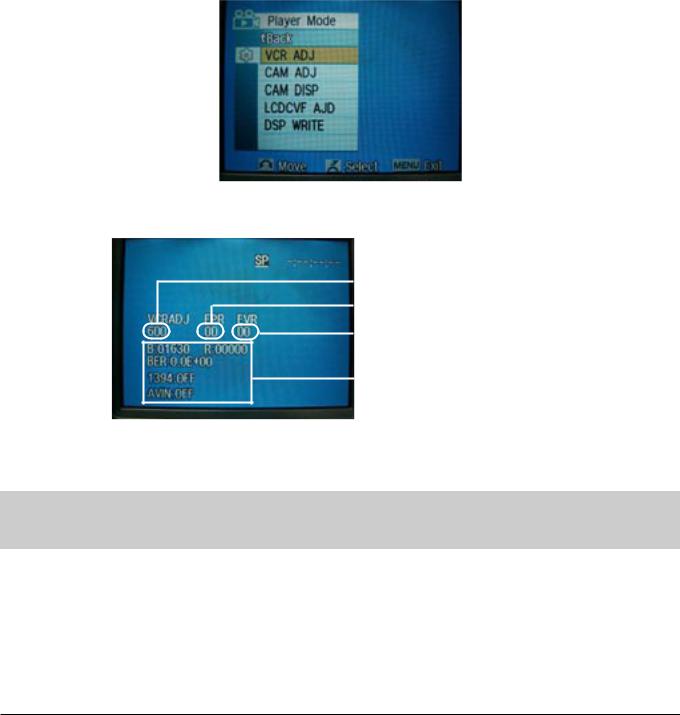
Alignment and Adjustments
[STEP 2]
ŒPress and hold the "STOP" and "PB ZOOM" buttons on the video camera at the same time for more than 5 seconds.
´ When monitor OSD appears as shown Fig. 3-2, the adjustment mode has been activated successfully. ˇ Move the “MENU Selector” to highlight VCR ADJ and push the “MENU Selector”.
¨Monitor OSD shows Fig. 3-3.
Then VCR adjustment mode has been activated successfully.
[STEP 3]
In order to complete the adjustment the power must be reset.
This can be done by disconnecting and reconnecting the power source.
Fig. 3-2
 Indicates current adjustment item
Indicates current adjustment item
 Stored value
Stored value
 Adjustment value
Adjustment value
 For Engineering Mode
For Engineering Mode
Fig. 3-3
3-1-2 VCR Adjustment
Note : This is the only electronic adjustment for the VCR.
Other addresses have already been assigned data during the manufacturing process.
We don’t need any adjustment for those addresses.
|
|
|
<Table 3-2> |
|
|
|
|
|
|
Mode(Address) |
Name |
Value |
|
Description |
61F |
SWP Position |
8C |
|
Head Switching Position Adjust |
ΠGet into VCR ADJUST mode.
´ Move to the VCR ADJUST address “6IF”.
ˇ Play standard tape, and “Head Switching Position” will be adjusted automatically (within 5 Seconds).
3-2 |
Samsung Electronics |

Alignment and Adjustments
3-2 Camera Adjustment
Note : How to adjust the camera system.
1)EEPROM stores confirmed adjustment value of each adjustment step.
2)DSP (Digital Signal Process : ICM01-Main PCB) digitalizes the camera signal.
3)When changing IC505-Main PCB of EEPROM, readjust Main PCB. While changing LCD PCB and CVF PCBalways readjust each part.
Since EEPROM stores confirmed adjustment value of each adjustment step, readjusting must be performed in order to store the changed data.
4)Adjust the following items after changing LENS Ass’y. Œ Lens Zoom Track
´Auto HALL ˇ Auto IRIS
5)Adjust the following items after changing EEPROM and Camera Main PCB. ΠLens Zoom Track
´Zoom VR Center
ˇ Auto HALL
¨ Auto IRIS
ˆ Auto White Balance (indoor)
Ø Auto White Balance (outdoor)
3-2-1 Adjustment Preparation
1)Before you start
ΠUse the buttons on the CAMCORDER when adjusting Camera.
´When changing the adjustment item, please press the “EASY-Q” and “DISPLAY” buttons on the CAMCORDER.
ˇ The adjustment value can be changed by moving the “MENU Selector” Left or Right. ¨ Press the “MENU Selector” to store each adjustment into EEPROM.
ˆ The OSD shows “OK” after finishing each adjustment step.
Ø In order to exit the adjustment mode, disconnect the power source.
2)Function of each buttons on the Sst Key
|
<Table 3-3> |
|
|
|
|
Buttons |
Description |
|
MENU Selector push (Confirm) |
Stores changed value in the adjustment and auto adjustment mode. |
|
|
|
|
MENU Selector Right (Data Down) |
Changes data in the adjustment state. |
|
|
||
MENU Selector Left (Data Up) |
||
|
||
|
|
|
EASY-Q (Mode Up) |
Changes mode. |
|
DISPLAY (Mode Down) |
||
|
Samsung Electronics |
3-3 |
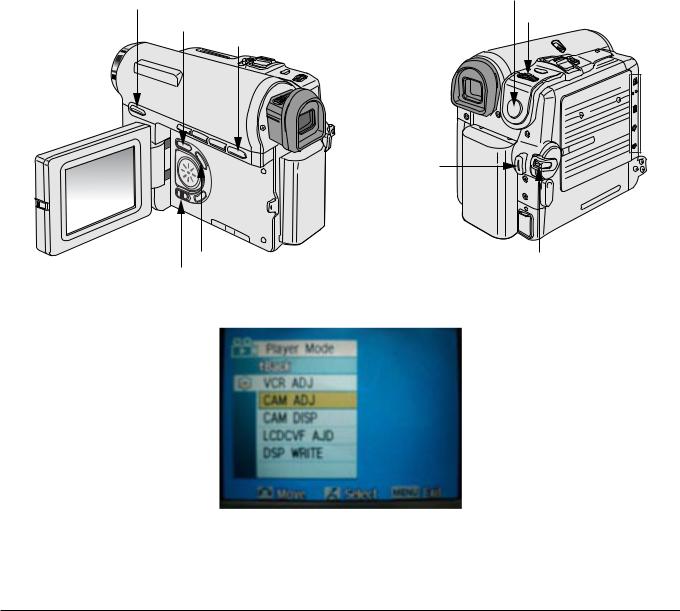
Alignment and Adjustments
5) How to set up the camera adjustment mode
[STEP 1]
ΠConnect the Power source.
´ Set the Power Switch to “CAM” position and Mode Switch to “TAPE” position.
[STEP 2]
ŒPress and hold the "STOP" and "PB ZOOM" buttons on the video camera at the same time for more than 5 seconds.
´ When monitor OSD appears as shown Fig. 3-5, the adjustment mode has been activated successfully. ˇ Move the “MENU Selector” to highlight CAM ADJ and push the “MENU Selector”.
¨Monitor OSD shows Fig. 3-6.
Then Camera adjustment mode has been activated successfully.
[STEP 3]
In order to complete the adjustment the power must be reset.
This can be done by disconnecting and reconnecting the power source.
MENU Button
EASY Q Button
MENU Selector
DISPLAY Button
STOP Button
DV
USB
AV
MIC
Start/Stop Button
PB ZOOM |
Power switch |
Mode switch |
|
|
Fig. 3-4 |
Fig. 3-5
3-4 |
Samsung Electronics |
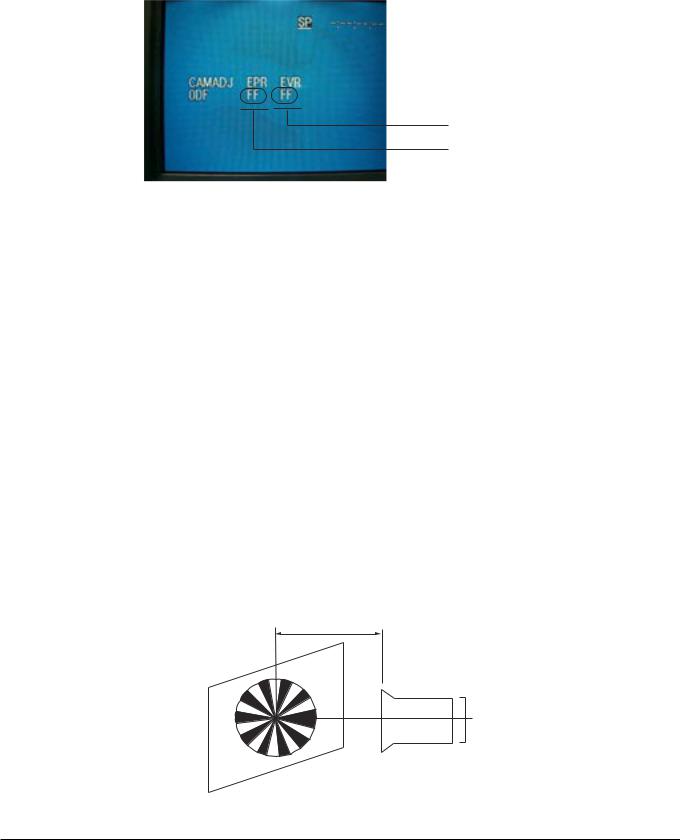
Alignment and Adjustments
3-2-2 Camera Adjustment
Note : "XX XX" indicate the previous preset value and adjusted value.
Press the “MENU Selector” (Confirm) to store the adjusted value.
 Adjusted values
Adjusted values
 Stored values
Stored values
Fig. 3-6
1) EEPROM Data Initialize
Caution : These adjustments must be done when installing a new EPROM (IC105) or Main PCB.
Œ Press the “EASY-Q”(Mode Up)/”DISPLAY”(Mode Down) buttons until CAMADJ displays “0DF XX XX”. ´ Use the “MENU Selector” (Data Up/Down) until the display data for EVR is “A0”.
ˇ Press the “MENU Selector” (Confirm).
¨ The OSD shows “OK” after finishing the initalize.
2) Lens Zoom Track
Caution : For whole zoom range, it shall be in focus.
The location of a focus lens is moving depending on the location of Zoom Lens. During adjusting, micom measures the focus location from a near distance to a long.
Œ Camera is set to E-E mode. ´ Focus chart photo.
ˇ Center the camera about 3m from a focus chart which, should be placed on a flat surfaced white or gray wall. ¨ Connect the video output terminal to a TV.
ˆ Press the “EASY-Q” (Mode Up)/”DISPLAY” (Mode Down) buttons until CAMADJ displays “0DE XX XX”.
ØPress the “MENU Selector” to begin adjustment.
The camera must be kept still when adjusting the zoom and focus lens.
If you don’t have any chart, you can use the object which has a lot of vertical line. The OSD shows “OK” after finishing the adjustment.
(The word “OK” is displayed for only a fraction of a second.)
3M ± 1cm
(Be sure to maintain the distance)
LENS CCD
Fig. 3-7
Samsung Electronics |
3-5 |

Alignment and Adjustments
3) Zoom VR Center
ΠConnect a video output terminal to a TV.
´ Press the “EASY”(Mode Up)/”DISPLAY”(Mode Down) buttons so that OSD shows “0D6 XX XX”. ˇ Press the “MENU Selector” (Confirm).
¨Then Micom finds out Zoom VR center position. Store Zoom VR center value in OB7.
4) Auto HALL
ΠConnect a video output terminal to a TV.
´ Press the “EASY-Q”(Mode Up)/”DISPLAY”(Mode Down) buttons so that OSD shows "0CD XX XX". ˇ Press the “MENU Selector” (Confirm).
¨Then micom finds out max. Hall value with an iris opened and min. Hall value with an iris closed. Store max. and min. value of Hall in OAD and OAC respectively.
ˆThe OSD shows “OK” after finishing the adjustment.
(The word “OK” is displayed for only a fraction of a second.)
5) Auto IRIS Level
ΠConnect a video output terminal to a wave form monitor and a TV.
´ Press the “EASY-Q”(Mode Up)/”DISPLAY”(Mode Down) buttons so that OSD shows "0CE XX XX". ˇ Press the “MENU Selector” (Confirm).
¨Then micom finds out max. Hall value with an iris opened and min.
Hall value with an iris closed. Store max. and min. value of in 00BC, 00BD and 00BB respectively.
ˆThe OSD shows “OK” after finishing the adjustment.
(The word “OK” is displayed for only a fraction of a second.)
6) Auto White Balance (indoor)
Œ Camera mode & 3100˚ K gray scale chart.
´ Connect a video output terminal to a vectorscope and a TV.
ˇ Press the “EASY-Q”(Mode Up)/”DISPLAY”(Mode Down) buttons so that OSD shows "0D4 XX XX".
¨Ensure that camera picks up image 40µs on 3100˚K gray scale chart precisely and the illumination is 1500~2000 Lux.
ˆPress the “MENU Selector” (Confirm) to ensure that white spot on a vectorscope is moving in the middle of screen.
ØThe OSD shows “OK” after finishing the adjustment.
(The word “OK” is displayed for only a fraction of a second.)
7) Auto White Balance (outdoor)
Œ Camera mode & 5100˚ K gray scale chart.
´ Connect a video output terminal to a vectorscope and a TV.
ˇ Press the “EASY-Q”(Mode Up)/”DISPLAY”(Mode Down) buttons so that OSD shows "0D5 XX XX".
¨Ensure that camera picks up image 40 µs on 5100 gray scale chart (3100 gray scale chart + C16 filter) precisely and the illumination is 1500~2000 Lux.
ˆPress the “MENU Selector” (Confirm) to ensure that white spot on a vectorscope is moving in the middle of screen.
ØThe OSD shows “OK” after finishing the adjustment.
(The word “OK” is displayed for only a fraction of a second.)
3-6 |
Samsung Electronics |
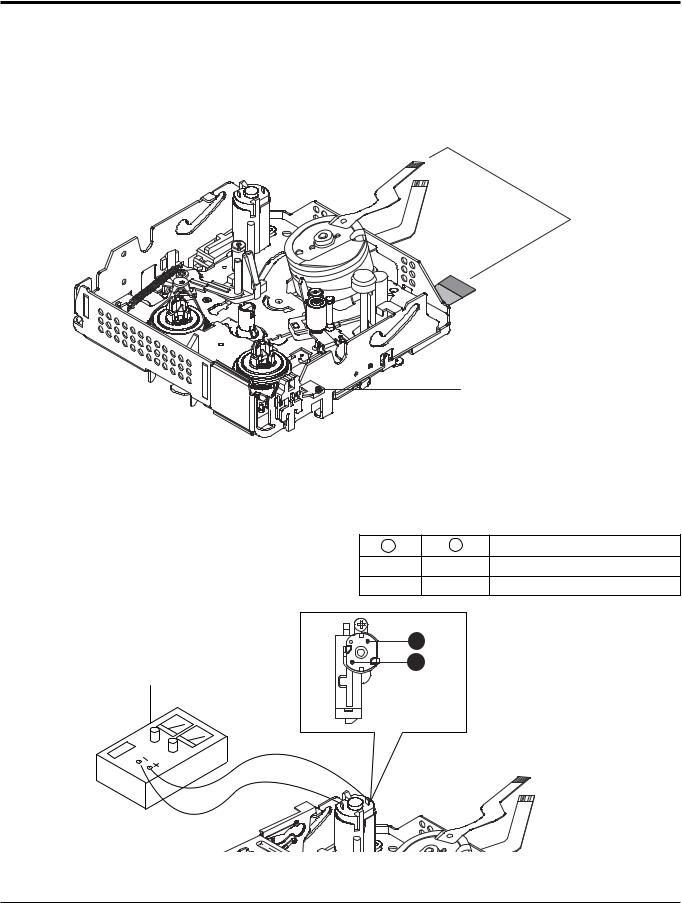
Alignment and Adjustments
3-3 Deck Adjustment
3-3-1 Operation Without Housing Assembly
1)Remove the Housing Ass’y from the Deck Ass’y.
2)Connect the Mechanical Chassis to the recorder circuit to supply voltage.
3)Set to Unload mode.
4)Press the S/W Push (Keep ON status)to start loading, and push the PLAY Key.
(Cover the Top/End sensor with black tape, because they do not operate.)
Note : For the removal of the Housing Ass’y refer to 4-2-2 (page 4-7).
Connceted the Recorder Circuit
SWITCH C-IN
Fig. 3-8
3-3-2 Setting Mechanical Mode (Without Recorder Circuit)
1)Set the power-supply output to approx. 3V~5V.
2)Choose the polarity (depending on whether loading or unloading).
3)Supply the voltage to the Motor Loading, and set to the desired mode.
|
|
<Table 3-4> |
|
|
|
A |
B |
Movement of Chassis |
+ |
- |
Unloading |
- |
+ |
Loading |
A
B
DC POWER SUPPLY
Samsung Electronics |
3-7 |
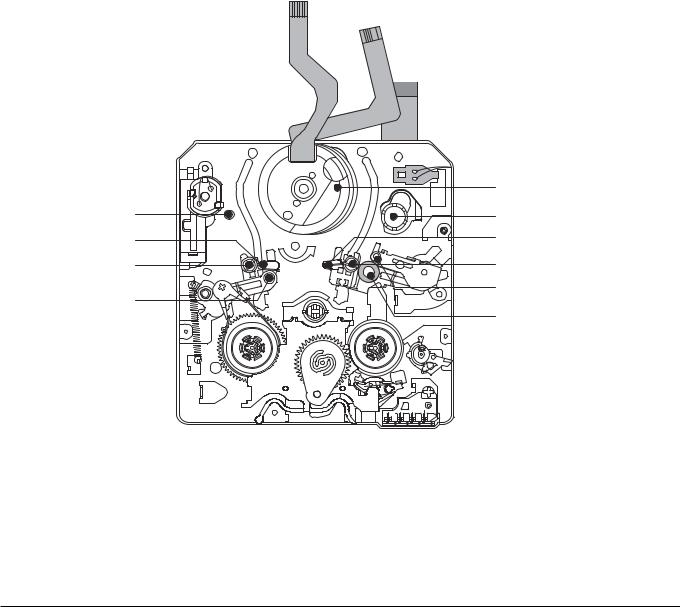
Alignment and Adjustments
3-3-3 Maintenance
Carry out the following periodic maintenance checks in order to fully exercise all functions, operations and tape. After repairing, service the set as follows:
1)Cleaning of Drum Assembly
ŒGently apply lens tissue soaked in ethyl alcohol to the Drum assembly.
Clean the Upper Drum assembly while rotating it slowly counterclockwise(by hand).
Note : Do not rotate the motor by power or rotate the Upper Drum assembly clockwise.
Also, the Head tip will be damaged if the lens tissue is moved in a perpendicular direction. Be sure to follow these instructions when cleaning the Drum Ass’y
2)Cleaning of Tape Path
ŒIn EJECT mode, clean the tape path system(from Pole Tension P1 through Pole Review P9, Pinch Roller and Capstan Shaft) and the Lower Drum. Using the lens tissue soaked in ethyl alcohol.
Note : Make sure that no oil or grease adheres to the lens tissue.
|
P5 |
P2 |
P8 |
P4 |
P6 |
P3 |
P7 |
P1 |
P9 |
|
PINCH ROLLER
Fig. 3-10
3-8 |
Samsung Electronics |
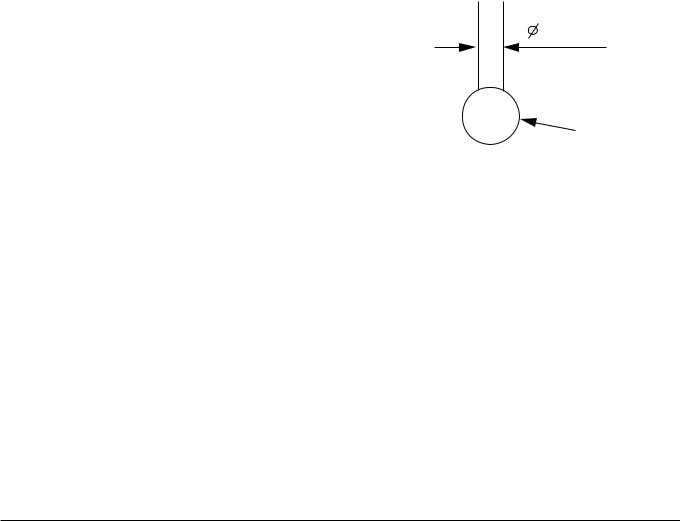
Alignment and Adjustments
3) Periodic Maintenance and Check List
When overhauling, refer to the following table.
<Table 3-5>
|
Maintenance checks |
|
|
|
Hours of use (H) |
|
|
|
|
Remark |
||
|
500 |
1000 |
1500 |
2000 |
2500 |
3000 |
3500 |
4000 |
4500 |
5000 |
||
|
|
|
||||||||||
Tape |
Cleaning of tape path |
O |
O |
O |
O |
O |
O |
O |
O |
O |
O |
|
|
|
|
|
|
|
|
|
|
|
|
|
|
path |
|
|
|
|
|
|
|
|
|
|
|
|
system |
Cleaning and degaussing of drum ass’y |
O |
O |
O |
O |
O |
O |
O |
O |
O |
O |
|
D |
Capstan Shaft |
|
6 |
|
6 |
|
6 |
|
6 |
|
6 |
|
S |
|
|
|
|
|
|
|
|
|
|
|
- Never let oil get on to the tape path |
R |
Gear Capstan |
|
6 |
|
6 |
|
6 |
|
6 |
|
6 |
|
Y |
|
|
|
|
|
surface. |
||||||
I |
|
|
|
|
|
|
|
|
|
|
|
|
S |
Gear Pully Shaft |
|
6 |
|
6 |
|
6 |
|
6 |
|
6 |
|
V |
|
|
|
|
|
|
||||||
T |
|
|
|
|
|
|
|
|
|
|
|
|
I |
Belt Timing |
|
Ů |
|
Ů |
|
Ů |
|
Ů |
|
Ů |
|
N |
|
|
|
|
|
|
||||||
E |
|
|
|
|
|
|
|
|
|
|
|
|
M |
|
|
|
|
|
|
|
|
|
|
|
|
Motor Loading |
|
Ů |
|
Ů |
|
Ů |
|
Ů |
|
Ů |
|
|
G |
|
|
|
|
|
|
||||||
Perform- |
Abnormal Noise |
|
Ů |
Ů |
Ů |
Ů |
Ů |
Ů |
Ů |
Ů |
Ů |
|
ance |
|
|
||||||||||
|
Back Tension |
|
Ů |
|
Ů |
|
Ů |
|
Ů |
|
Ů |
|
Confir- |
Brake System |
|
Ů |
|
Ů |
|
Ů |
|
Ů |
|
Ů |
|
mation |
|
|
|
|
|
|
||||||
|
PB, REV Torque Measurement |
|
Ů |
|
Ů |
|
Ů |
|
Ů |
|
Ů |
|
O : Cleaning ¨ : Oil Ů : Confirmation
Ů When lubrication bearings, be sure to keep the oil free of dust. (Oil contaminated with dust might
cause the bearings to wear out or seize.) |
2mm |
|
ŮA “drop”of oil is defined as the amount attached to the tip of a Ø 2mm stick as shown in Fig. 3-11.
OIL
Fig. 3-11
Samsung Electronics |
3-9 |
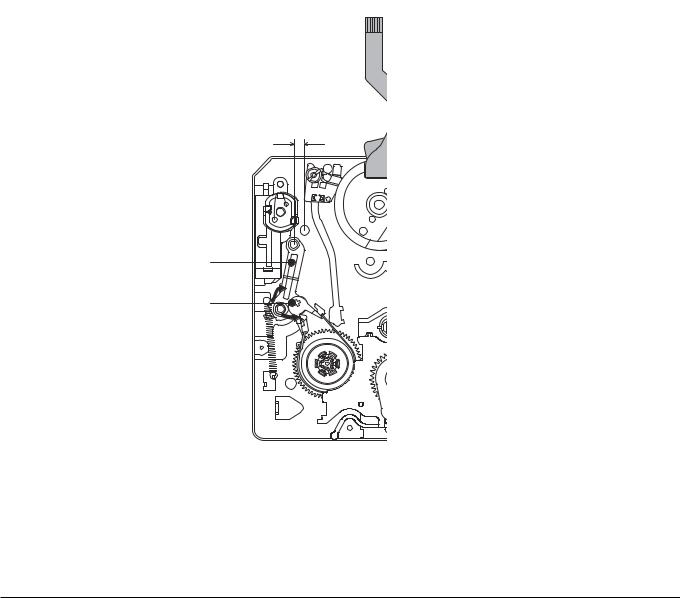
Alignment and Adjustments
3-3-4 Mechanical Check and Adjustment
3-3-4(a) Tension Regulator Adjustment
1)Disassembly
ŒFor the removal of the Housing Ass’y refer to 4-2-2 (page 4-7).
2)Adjustment
ŒSet to PLAY mode (without cassette tape).
´Check that the distance between external surface of Holder Loading and extenal diamater of Arm Tension is 1±0.5mm. (Fig. 3-12)
ˇ If necessary, proceed to step 4.
¨If the Arm Tension Œ is located inside (or right) the position specified, adjust the Cap Adjust Œ toward arrow “A”. (If it is located outside (or left), adjust toward arrow “B”.)
Note : Check if the Arm Tension can be moved toward arrow “C” in PB mode.
3)Reassembly
ŒFor the removal of the Housing Ass’y refer to 4-2-2 (page 4-7).
1  0.5
0.5
ARM TENSION Œ
"A"
CAP ADJUST ´
"B"
Fig. 3-12
3-10 |
Samsung Electronics |

Alignment and Adjustments
3-3-4(b) Back Tension Confirmation
1)Set up the cassette-torque tape.
2)Set to CAMERA mode, push the EDIT(+) KEY and check that the torque value of Reel S is 4±1g.cm.
3)If necessary, proceed to step 4.
4)If the Tension value is Low specified, moved to toward “a”. If the Tension value is High specified, moved to toward “b”.
Reference : After changed, insert Cassette torque tape and confirm torque value.
b
a
Fig. 3-13
3-3-4(c) PB/REV Torque check
1)Set up the cassette torque tape.
2)Set to CAMERA mode, Push the EDIT(+) button and check that the torque value of Reel T is 9.5±3.5g.cm.
3)Push the EDIT(-) button and check that the torque value of Reel S is 15±4g.cm.
4)If necessary, replace the defective Reel Disk S, T Ass’y.
3-3-4(d) Reel Table Height Check
1)Removal
ŒFor the removal of the Housing Ass’y refer to 4-2-2 (page 4-7). ´ For the removal of the Idler Ass’y refer to 4-2-3 (page 4-8).
2)Check
ŒUsing vernier calipers, check the following distances : From the upper surface of the Main Chassis to the resting surfaces of Reel S, T table should each be 3.9±0.15mm.
3)Mounting
ŒFor the removal of the Idler Ass’y refer to 4-2-3 (page 4-8).
´ For the removal of the Housing Ass’y refer to 4-2-2 (page 4-7).
REEL DISK S TABLE |
|
|
|
|
|
|
|
|
|
|
|
|
|
|
|
|
|
|
|
|
|
|
|
|
|
|
|
|
|
|
|
|
|
|
|
|
|
|
|
|
|
|
|
|
|
REEL DISK T TABLE |
|||||||||||||||||||||
|
|
|
|
|
|
|
|
|
|
|
|
|
|
|
|
|
|
|
|
|
|
|
|
|
|
|
|
||||||||||||||||||||||||||||||||||||||||
RESTING SURFACE |
|
|
|
|
|
|
|
|
|
|
|
|
|
|
|
|
|
|
|
|
|
|
|
|
|
|
|
|
|
|
|
|
|
|
|
|
|
|
|
|
|
|
|
|
|
|
|
RESTING SURFACE |
|||||||||||||||||||
|
|
|
|
|
|
|
|
|
|
|
|
|
|
|
|
|
|
|
|
|
|
|
|
|
|
|
|
|
|||||||||||||||||||||||||||||||||||||||
|
|
|
|
|
|
|
|
|
|
|
|
|
|
|
|
|
|
|
|
|
|
|
|
|
|
|
|
|
|
|
|
||||||||||||||||||||||||||||||||||||
|
|
|
|
|
|
|
|
|
|
|
|
|
|
|
|
|
|
|
|
|
|
|
|
|
|
|
|
|
|
|
|
|
|
|
|
|
|
|
|
|
|
|
|
|
|
|
|
|
|
|
|
|
|
|
|
|
|
|
|
|
|
|
|
|
|
|
|
|
|
|
|
|
|
|
|
|
|
|
|
|
|
|
|
|
|
|
|
|
|
|
|
|
|
|
|
|
|
|
|
|
|
|
|
|
|
|
|
|
|
|
|
|
|
|
|
|
|
|
|
|
|
|
|
|
|
|
|
|
|
|
|
|
|
|
|
|
|
|
|
|
|
|
|
|
|
|
|
|
|
|
|
|
|
|
|
|
|
|
|
|
|
|
|
|
|
|
|
|
|
|
|
|
|
|
|
|
|
|
|
|
|
|
|
|
|
|
|
|
|
|
|
|
|
|
|
|
|
|
|
|
|
|
|
|
|
|
|
|
|
|
|
|
|
|
|
|
|
|
|
|
|
|
|
|
|
|
|
|
|
|
|
|
|
|
|
|
|
|
|
|
|
|
|
|
|
|
|
|
|
|
|
|
|
|
|
|
|
|
|
|
|
|
|
|
|
|
|
|
|
|
|
|
|
|
|
|
|
|
|
|
|
|
|
|
|
|
|
|
|
|
|
|
|
|
|
|
|
|
|
|
|
|
|
|
|
|
|
|
|
|
|
|
|
|
|
|
|
|
|
|
|
|
|
|
|
|
|
|
|
|
|
|
|
|
|
|
|
|
|
|
|
|
|
|
|
|
|
|
|
|
|
|
|
|
|
|
|
|
|
|
|
|
|
|
|
|
|
|
|
|
|
|
|
|
|
|
|
|
|
|
|
|
|
|
|
|
|
|
|
|
|
|
|
|
|
|
|
|
|
|
|
|
|
|
|
|
|
|
|
|
|
|
|
|
|
|
|
|
|
|
|
|
|
|
|
|
|
|
|
|
|
|
|
|
|
|
|
|
|
|
|
|
|
|
|
|
|
|
|
|
|
|
|
|
|
|
|
|
|
|
|
|
|
|
|
|
|
|
|
|
|
|
|
|
|
|
|
|
|
|
|
|
|
|
|
|
|
|
|
|
|
|
|
|
|
|
|
|
|
|
|
|
|
|
|
|
|
|
|
|
|
|
|
|
|
|
|
|
|
|
|
|
|
|
|
|
|
|
|
|
|
|
|
|
|
|
|
|
|
|
|
|
|
CHASSIS MAIN
Fig. 3-14
Samsung Electronics |
3-11 |
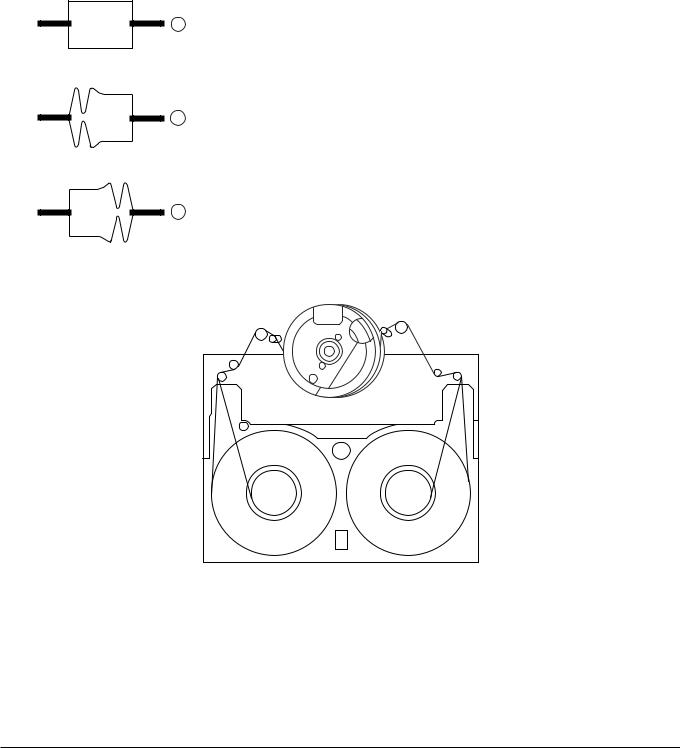
Alignment and Adjustments
3-3-5 Tape Path Adjustment
3-3-5(a) Preparation for Adjustment
Œ Clean the tape running surface (Poles, Drum, Capstan Shaft, Pinch Roller). ´ Observe the PB RF signal and Head Switching Pulse on an oscilloscope. ˇ Play back the alignment tape.
¨Check that the waveform of the RF signal is flat at both inlet and outlet(A in Fig. 3-15). If not flat (B or C in Fig. 3-15), do adjustments 3-3-5(b) through 3-3-5(d).
INLET OUTLET
A NORMAL
B DEFECT AT INLET
C DEFECT AT OUTLET
Fig. 3-15
P5
P7
P3 P4
P1 |
P2 |
P9 |
P8
Fig. 3-16
3-12 |
Samsung Electronics |
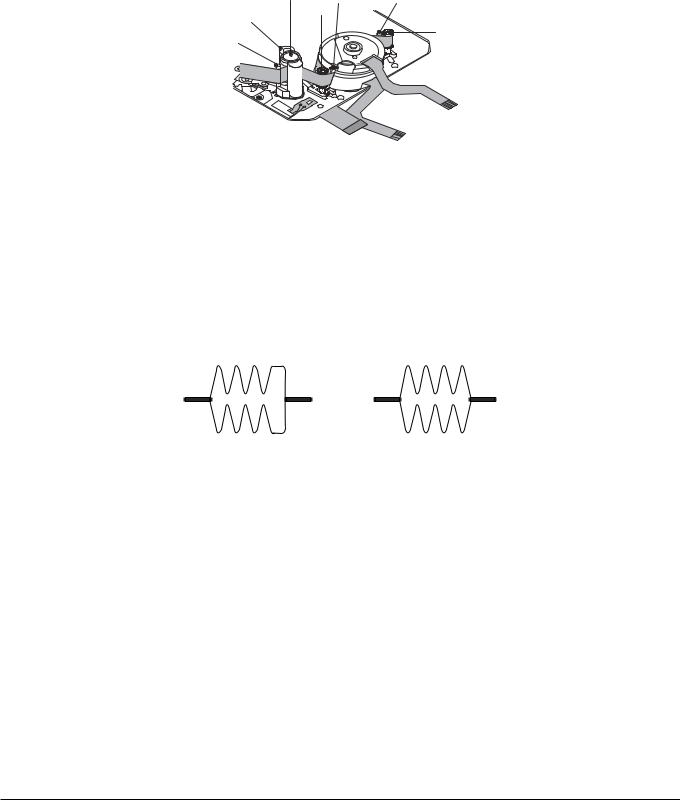
Alignment and Adjustments
3-3-5(b) Tracking adjustment
ΠPlay Back the alignment tape.
´ Turn P3 to flatten the waveform at the inlet. ˇ Turn P7 to flatten the waveform at the outlet.
MOTOR CAPSTAN P6 |
P4 |
P7
P8
P3
P9
Fig. 3-17
3-3-5(c) Take Up Path Adjustment
ŒPlay back the alignment tape, and confirm that the tape is not twisted between the Guide Roller T and Capstan. (Fig. 3-17)
´ Set to REV mode and observe the outlet waveform of PB RF signal. (Fig. 3-18)
NOTE : If the outlet waveform is out-of-spec, replace the Arm Review or the Arm Pinch Ass’y, and redo steps 1 and 2.
(DEFECTIVE) |
(CORRECT) |
Fig. 3-18
Samsung Electronics |
3-13 |
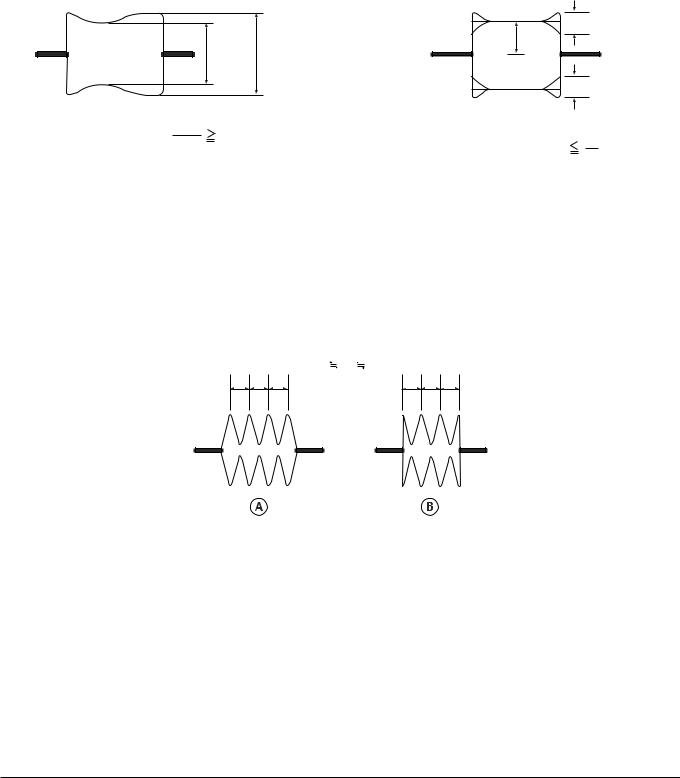
Alignment and Adjustments
3-3-5(d) Check After Adjustment
1)Tracking Check
ŒPlayback the alignment tape.
´Confirm that the minimum amplitude value(E min.)is 80% of the maximum value(E max.) or larger. (Fig. 3-19)
ˇ Confirm that no large fluctuation occur on the waveform. (Fig. 3-20)
|
|
A |
C |
|
|
|
|
|
|
||
|
Emin |
Emax |
|
|
|
|
|
|
C |
|
|
Emin |
80(%) |
|
1 |
|
|
Emax |
C |
A |
|||
|
|||||
|
|
8 |
|||
Fig. 3-19 |
|
Fig. 3-20 |
|
|
2) CUE and REV Check
ΠPlayback the alignment tape, and set to REV mode.
Confirm that the waveform peaks have a uniform Pitch. (Fig. 3-21 A)
If the track pitch is not uniform, do section 3-3-5(b) (Tracking adjustment). ´ Set to CUE mode.
Confirm that the waveform peaks still have a uniform pitch. (Fig. 3-21 B) If the track pitch is not uniform, do section 3-3-5(b) (Tracking Adjustment).
a |
b |
c |
a b c |
|
a b c |
Fig. 3-21
3-14 |
Samsung Electronics |
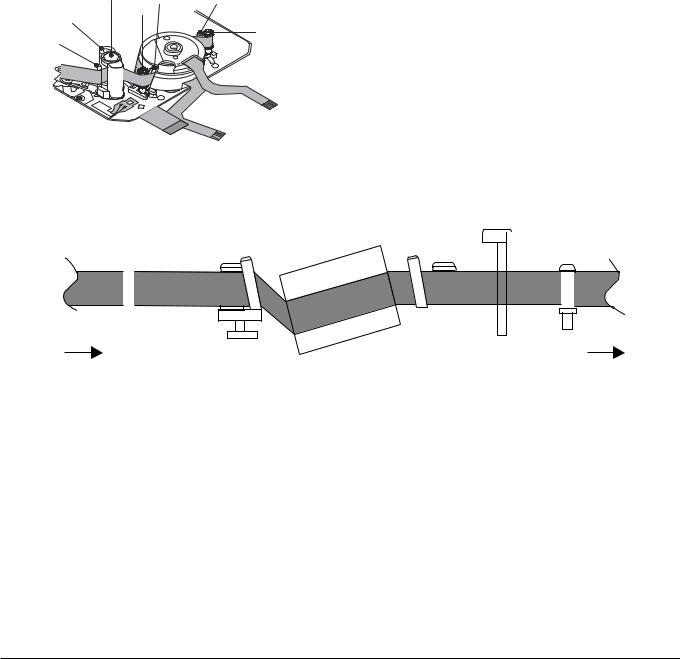
Alignment and Adjustments
3) Rise Time Check
ΠPlayback the alignment tape.
´Set to playback mode, and confirm that the waveform of PB RF signal rises flat within 3 seconds. Also confirm that the tape is not twisted or curled around the Pinch Roller. (Fig. 3-23)
ˇRun the tape in CUE/REV and FF/REW modes, then playback.
Confirm the waveform of PB RF signal rises flat within 3 seconds. Also confirm that the tape is not twisted or curled around the Pinch Roller.
¨ Repeat steps 2. and 3.
4) Tape Path Check
ŒIn CUE and REV modes, check that the tape is not curled around the P3, P7 upper flange and P9 upper/Lower flanges.
MOTOR CAPSTAN P6 |
P4 |
P7
P8
P3
P9
Fig. 3-22
P1 |
P2 |
P3 P4 |
P6 |
P7 |
|
|
|
|
|
|
|
|
|
|
|
P9 |
|||||||||||||||
|
|
|
|
|
|
|
|
|
|
|
|
|
|
|
|
|
|
|
|
|
|
|
|
|
|
|
|
|
|
|
|
|
|
|
|
|
|
|
|
|
|
|
|
|
|
|
|
|
|
|
|
|
|
|
|
|
|
|
|
|
|
|
|
|
|
|
|
|
|
|
|
|
|
|
|
|
|
|
|
|
|
|
|
|
|
|
|
|
|
|
|
|
|
|
|
|
|
|
|
|
|
|
|
|
|
|
|
|
|
|
|
|
|
|
|
|
|
|
|
|
|
|
|
|
|
|
|
|
|
|
|
|
|
|
|
|
|
|
|
|
|
|
|
|
|
|
|
|
|
|
|
|
|
|
|
|
|
|
|
|
|
|
|
|
|
|
|
|
|
|
|
|
|
|
|
|
|
|
|
|
|
|
|
|
|
|
|
|
|
|
|
FROM THE S REEL |
TO THE T REEL |
Fig. 3-23
Samsung Electronics |
3-15 |
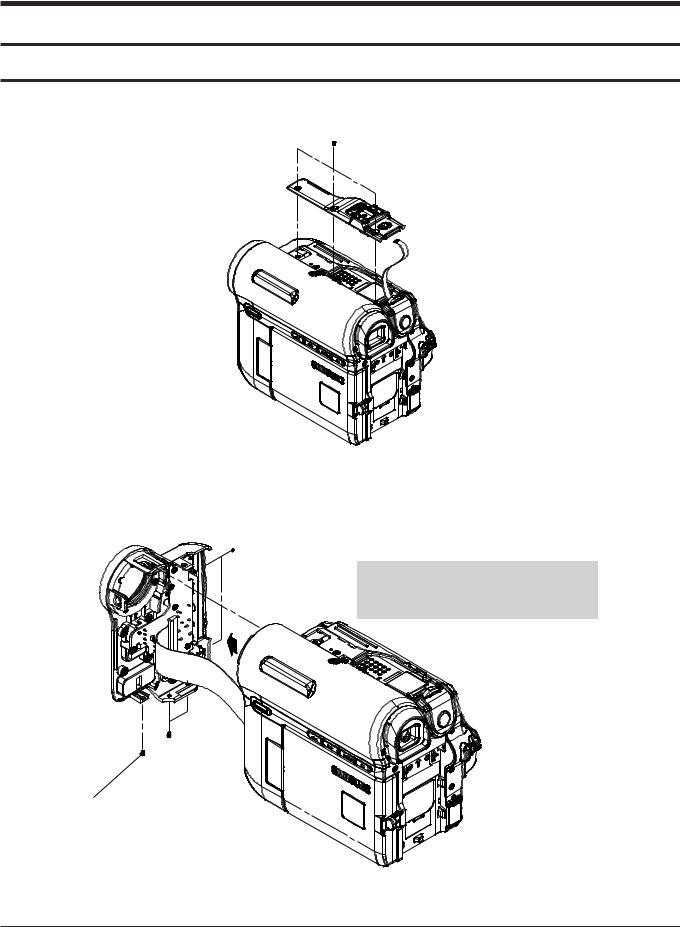
4. Disassembly and Reassembly
4-1 Cabinet and PCB
4-1-1 Ass’y Zoom Removal
ŒREMOVE 3 SCREWS
(M 1.7 X 4 BLK)
Fig. 4-1 Ass’y Zoom Removal
4-1-2 Ass’y Front Removal
 ŒREMOVE 2 SCREWS
ŒREMOVE 2 SCREWS
(M1.7 X 4 BLK)
Caution : Please indicate that the connector must be detached before separating the Front Assembly
´REMOVE 2 SCREWS
(M1.7 X 4 BLK)
ˇREMOVE 1 SCREW
(M1.7 X 5 WHT)
Fig. 4-2 Ass’y Front Removal
Samsung Electronics |
4-1 |
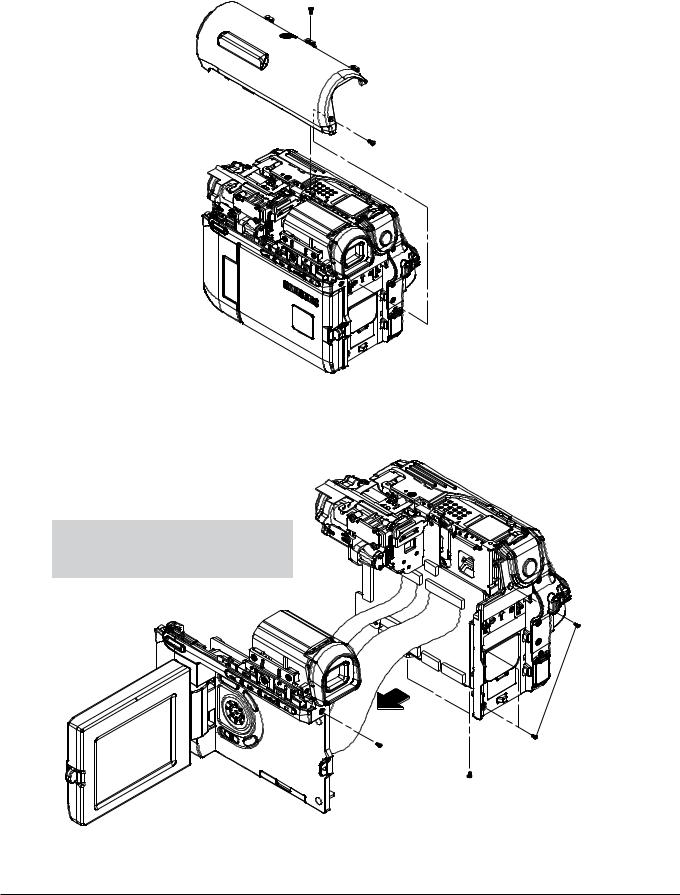
Disassembly and Reassembly
4-1-3 Ass’y Top Removal
ŒREMOVE 1 SCREW
(M1.7 X 4 BLK)
´REMOVE 1 SCREW
(M1.7 X 5 WHT)
Fig. 4-3 Ass’y Top Removal
4-1-4 Ass’y Left Removal
Caution : Please indicate that the connectors must be detached before separating the Left Assembly
ŒREMOVE 3 SCREWS ˇREMOVE 1 SCREW (M1.7 X 4 BLK)
(M1.7 X 5 WHT)
´REMOVE 2 SCREWS
(M1.7 X 4 BLK)
Fig. 4-4 Ass’y Left Removal
4-2 |
Samsung Electronics |
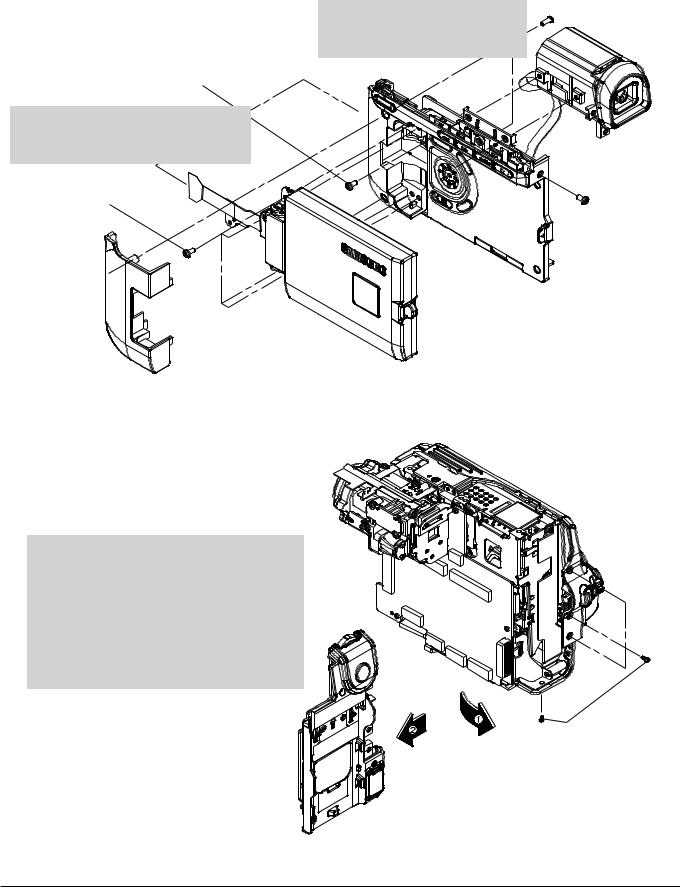
4-1-5 Ass’y LCD & EVF/CVF Removal
¨REMOVE 2 SCREWS
(M1.7 X 3 WHT)
Caution : Please indicate that this connector must be detached before separating the LCD Assembly
ˇREMOVE 4 SCREWS (T2 X 5 BLK)
Caution : Please indicate that there is a connector on the View-Finder that must be detached
Fig. 4-5 Ass’y LCD & EVF/CVF Removal
4-1-6 Ass’y Rear Removal
Caution : The Rear Assembly is connected to the Main PCB. Pulling it to the left as indicated in the illustraton can cause the connector to break. This removal instruction should indicate that the Rear assembly should be pulled Forward first
in order to disconnect it from the Main PCB. Then it can be pulled to the left
to separate it from the Main PCB
Fig. 4-6 Ass’y Rear Removal
Disassembly and Reassembly
ŒREMOVE 3 SCREWS (T1.7 X 4 BLK)
´REMOVE 1 SCREW
(M1.7 X 5 WHT)
ŒREMOVE 4 SCREWS (M1.7 X 4 BLK)
Samsung Electronics |
4-3 |
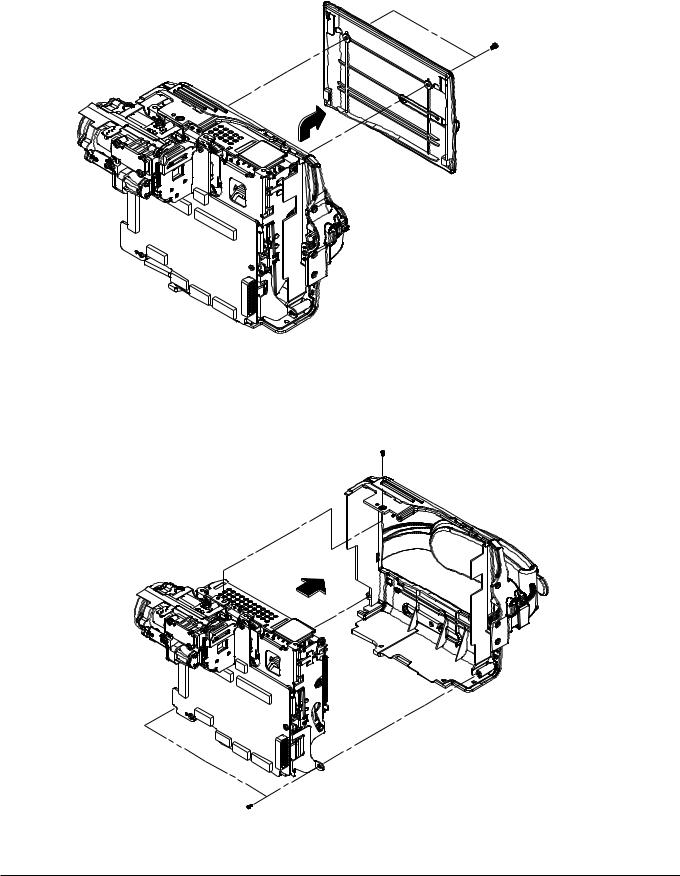
Disassembly and Reassembly
4-1-7 Ass’y Cover Housing Removal
ŒREMOVE 2 SCREWS
(M1.4 X 3 BLK)
Fig. 4-7 Ass’y Cover Housing Removal
4-1-8 Ass’y Right Removal
ŒREMOVE 2 SCREWS
(M1.7 X 4 BLK)
´REMOVE 2 SCREWS (T1.7 X 4 BLK)
Fig. 4-8 Ass’y Right Removal
4-4 |
Samsung Electronics |
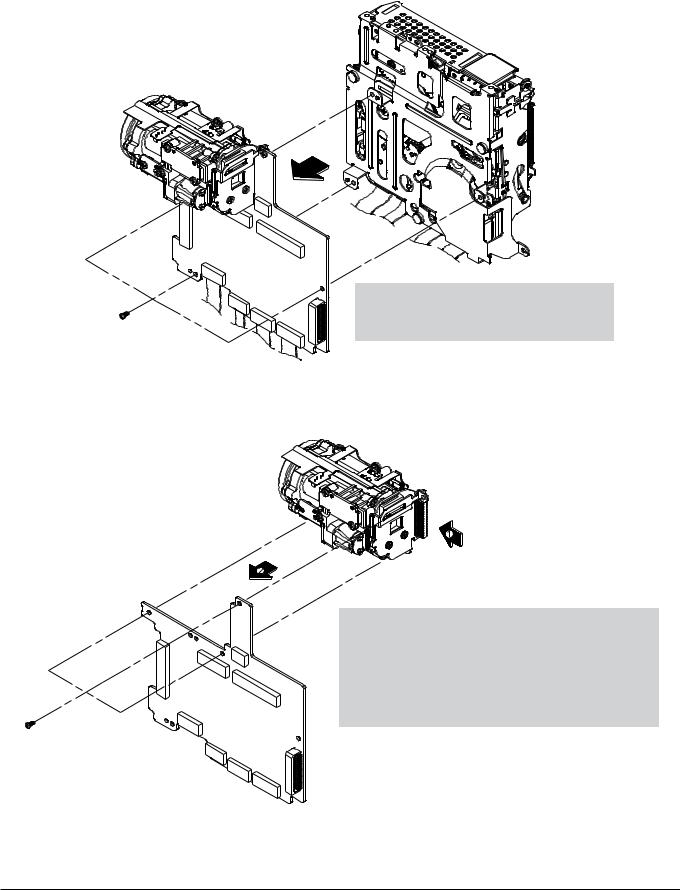
4-1-9 Ass’y Deck Removal
ŒREMOVE 3 SCREWS (M1.7 X 2.5 BLK)
4-1-10 Ass’y Main PCB Removal
ŒREMOVE 3 SCREWS (M1.7 X 2.5 BLK)
Disassembly and Reassembly
Caution : Please indicate that these connectors must be detached before separating the Deck Assembly from the MAIN PCB.
Fig. 4-9 Ass’y Deck Removal
Caution : The Lens Assembly is connected to the Main PCB. Pulling it to the left as indicated in the illustration can cause the connector to break. This removal instruction should indicate that the Lens assembly should be pulled Forward first in order to disconnect it from the Main PCB. Then it can be pulled to the left to separate it from the Main PCB.
Fig. 4-10 Ass’y Main PCB Removal
Samsung Electronics |
4-5 |
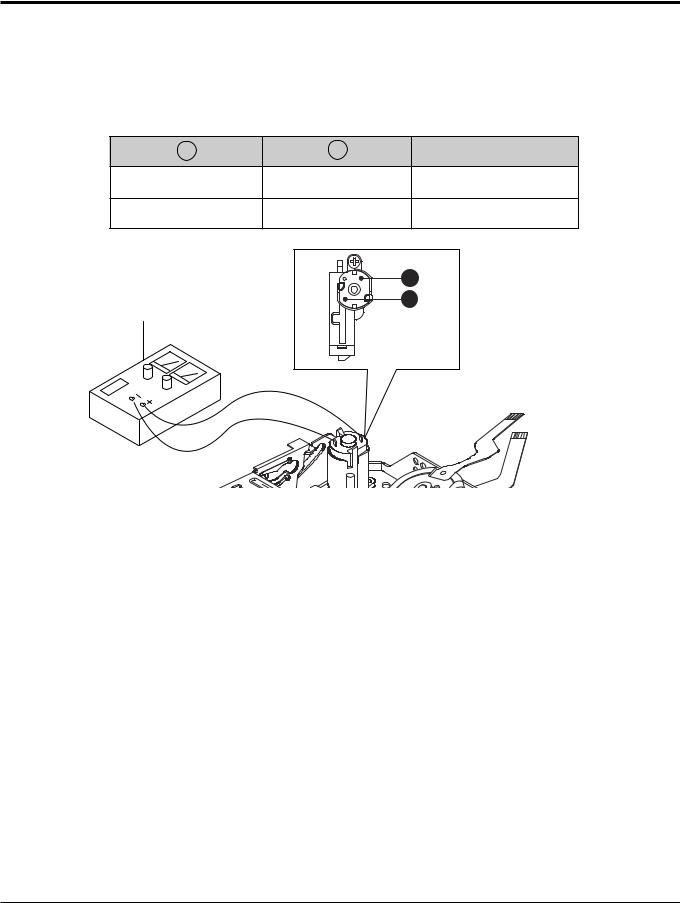
Disassembly and Reassembly
4-2 Deck
4-2-1 How to Load and Unload (Setting the Mechanical Modes)
1)Set the power-supply output to approximately 3V~5V, and connect it to the Motor Loading(= Loading Motor).
2)Choose the polarity depending on whether loading or unloading. (See Table 4-1)
3)Supply the voltage to the Motor Loading(= Loading Motor).
|
<Table 4-1> |
|
A |
B |
Movement of Chassis |
+ |
_ |
Unloading |
|
||
_ |
+ |
Loading |
|
||
|
|
A |
DC POWER SUPPLY |
|
B |
|
|
Fig. 4-11 Loading and Unloading
4-6 |
Samsung Electronics |
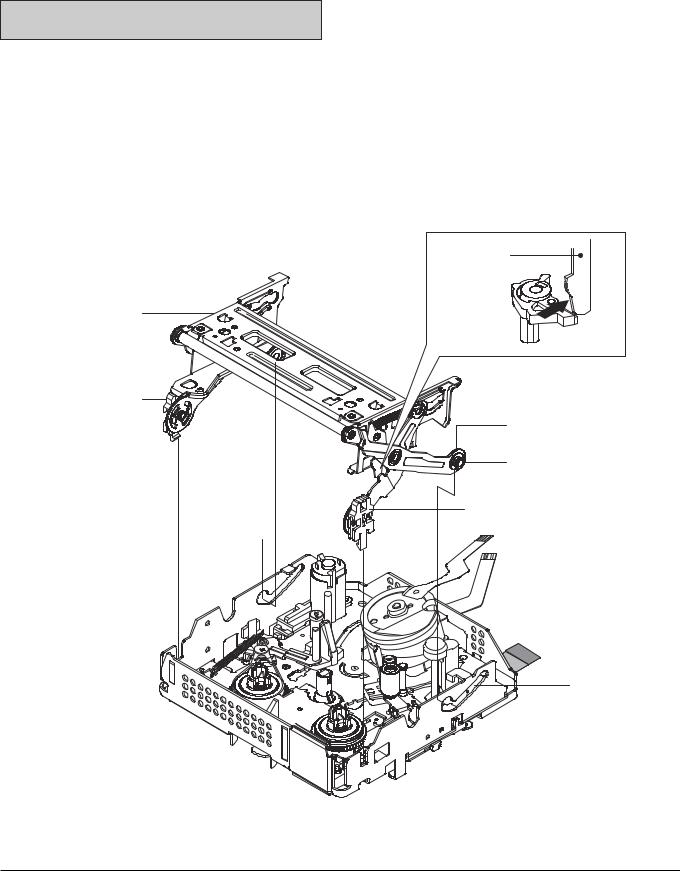
4-2-2 Housing Ass’y
4-2-2(a) Disassembly
Note : Do disassembly and reassembly in the unloading mode.
1)Push the Lever(see arrow “A”, Detail A) turn the Lever Lock Œ and open the Housing Ass’y ”.
2)Separate the Hook of Housing Lock L ´ and Housing Lock R ˇ and then lift it.
3)Separate the Shape of Pin L and R ˆ from Cam Parts Ø, ∏ of Main Chassis and then lift the Housing Ass’y ”.
HOUSING ASS'Y ”
HOUSING LOCK L ´
ØCAM PART
Disassembly and Reassembly
4-2-2(b) Reassembly
1)Mount the Shape of Pin L and R ˆ to Cam Parts Ø, ∏ of Main Chassis.
2)Mount Housing Lock L ´, R ˇ to right and left , and then locked.
ŒLEVER LOCK
"A"
<DETAIL A>
¨LEVER HOUSING
ˆSHAPE OF PIN
3ˇ HOUSING LOCK R
∏CAM PART
Fig. 4-12 Housing Ass’y
Samsung Electronics |
4-7 |

Disassembly and Reassembly
4-2-3 Cover Reel Ass’y, Idler Ass’y
4-2-3(a) Disassembly |
4-2-3(b) Reassembly |
||
1) |
Lift the Cover Reel Ass’y Œ (See arrow “A”). |
1) |
Fit the Idler Ass’y ´ into the Pin. |
2) |
Then lift the Idler Ass’y ´. |
2) |
Mount the Cover Reel Ass’y Œ to the Main Chassis |
|
|
|
is groove in the oposite direction of arrow “A”. |
"A"
 ΠCOVER REEL ASS'Y
ΠCOVER REEL ASS'Y



 ´2 IDLER ASS'Y
´2 IDLER ASS'Y
Fig. 4-13 Cover Reel Ass’y, Idler Ass’y
4-8 |
Samsung Electronics |
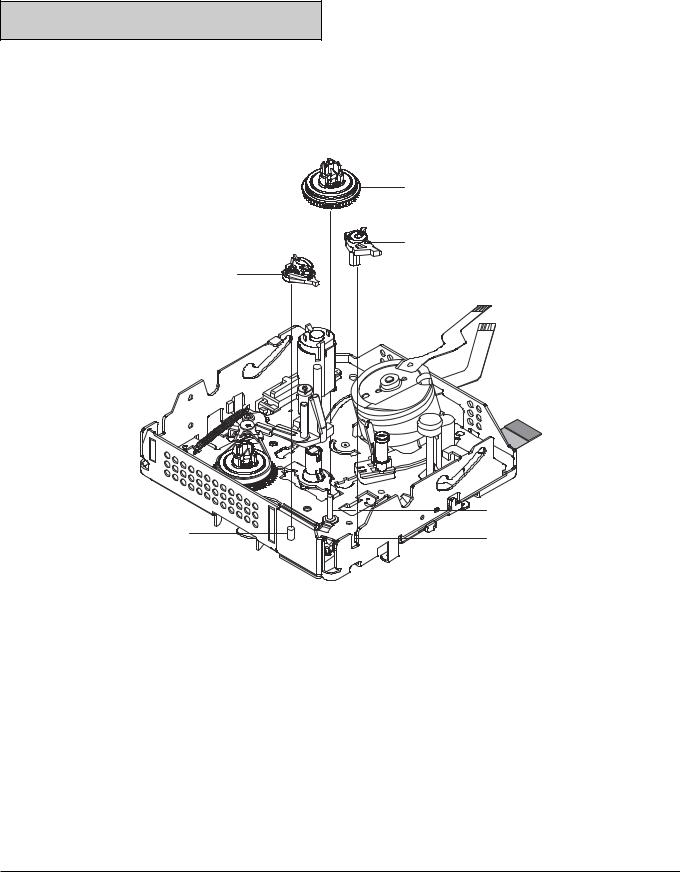
4-2-4 Reel Disk T, Brake T, Lever Eject
4-2-4(a) Disassembly
Note 1 : When disassembling, take care not to deform the part. Do not stain the post.
1)Lift up the Brake T ´.
2)Lift up the Reel Disk T Œ.
3)Separate the Lever Eject’s hook from the Main Chassis, and then Lift up the Lever Eject ˇ.
BRAKE T ´
Disassembly and Reassembly
4-2-4(b) Reassembly
1)Insert the Lever Eject ˇ into the shape of pin ¨, and then lock the Lever Eject’s hook Eliminate this step.
2)Mount the Reel Disk T Œ to the pin Ø.
3)Insert the Brake T ´ into the shape of pin ˆ.
ΠREEL DISK T
ˇ LEVER EJECT
|
6 |
|
Ø PIN |
SHAPE OF PIN ˆ |
4 |
|
¨ SHAPE OF PIN |
|
Fig. 4-14 Reel Disk T, Brake T, Lever Eject |
Samsung Electronics |
4-9 |
